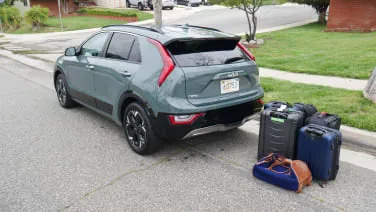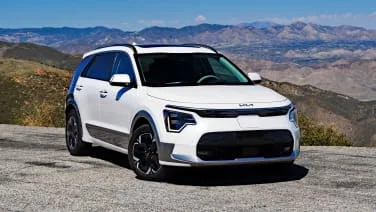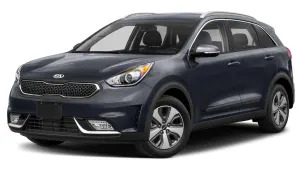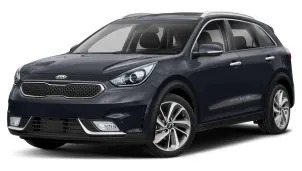EX 4dr Front-Wheel Drive Sport Utility
2019 Kia Niro
SANTA CRUZ, Calif. — The Kia Niro EV rounds out the Niro trio, and is the most impressive on paper. With the same 64-kWh battery and 201-horsepower electric motor as the Hyundai Kona Electric, it's rated at 239 miles of driving range between charges. Granted, 239 miles is less than the 258 miles the Kona EV gets on paper, so we were eager to see what the differences were between the similar EVs. After spending an icy, frigid weekend driving (and falling in love with) the Hyundai Kona Electric around Michigan we hopped on a plane, and headed to Santa Cruz to try out the 2019 Kia Niro EV (and to escape the cold). With a longer wheelbase and greater overall length than the Kona, the Niro EV offers a little more rear legroom — about three inches extra. As a 6-footer, I didn't find it uncomfortable to squeeze in behind an even taller driver. This bodes well for those of us with car seats we need to install in the back of our EVs. The Niro EV also boasts more luggage space than the Kona, with 18.5 cubic feet behind the rear seats, and 53 cubic feet with the seats folded down. We were impressed by the large rear opening and the spaciousness of the cargo area. The driver's seating position took a lot of adjustment to get comfortable in, a problem we didn't have in the Kona. No matter what we did, we felt like we were sitting too high up in the vehicle, but eventually it began to feel natural as our focus shifted from the interior around us to the road in front of us. Still, every time we got back in the car, we felt the need to try to improve the seating position. At least the seats were comfortable and supportive. Thankfully, Kia didn't go overboard with the styling of the Niro EV, and that goes for the interior, too. The oddest thing is the big rotary gear selector. While it looks like it would be in the way of the cupholder, it didn't interfere with grabbing our coffee, and it's more intuitive to use than the Kona Electric's separate PRDN buttons. The rest of the interior is about what you'd expect. There's a lot of plastic, a center stack that's maybe just a little too busy with buttons and controls, a well-incorporated touchscreen and a digital instrument cluster. It's quiet when you turn it on and begin to drive away, as you would expect. Listen carefully and you'll hear the spacey hum of its pedestrian warning system at low speeds, which shuts off as you approach 20 miles per hour. From there, you'll be able to hear the whine of the electric powertrain as you accelerate. There's a little more noise than in the Kona, which apart from the looks is the first clue that the Niro EV is a little sportier feeling than its subdued sibling. Mash the throttle, and the Niro …
Full Review
SANTA CRUZ, Calif. — The Kia Niro EV rounds out the Niro trio, and is the most impressive on paper. With the same 64-kWh battery and 201-horsepower electric motor as the Hyundai Kona Electric, it's rated at 239 miles of driving range between charges. Granted, 239 miles is less than the 258 miles the Kona EV gets on paper, so we were eager to see what the differences were between the similar EVs. After spending an icy, frigid weekend driving (and falling in love with) the Hyundai Kona Electric around Michigan we hopped on a plane, and headed to Santa Cruz to try out the 2019 Kia Niro EV (and to escape the cold). With a longer wheelbase and greater overall length than the Kona, the Niro EV offers a little more rear legroom — about three inches extra. As a 6-footer, I didn't find it uncomfortable to squeeze in behind an even taller driver. This bodes well for those of us with car seats we need to install in the back of our EVs. The Niro EV also boasts more luggage space than the Kona, with 18.5 cubic feet behind the rear seats, and 53 cubic feet with the seats folded down. We were impressed by the large rear opening and the spaciousness of the cargo area. The driver's seating position took a lot of adjustment to get comfortable in, a problem we didn't have in the Kona. No matter what we did, we felt like we were sitting too high up in the vehicle, but eventually it began to feel natural as our focus shifted from the interior around us to the road in front of us. Still, every time we got back in the car, we felt the need to try to improve the seating position. At least the seats were comfortable and supportive. Thankfully, Kia didn't go overboard with the styling of the Niro EV, and that goes for the interior, too. The oddest thing is the big rotary gear selector. While it looks like it would be in the way of the cupholder, it didn't interfere with grabbing our coffee, and it's more intuitive to use than the Kona Electric's separate PRDN buttons. The rest of the interior is about what you'd expect. There's a lot of plastic, a center stack that's maybe just a little too busy with buttons and controls, a well-incorporated touchscreen and a digital instrument cluster. It's quiet when you turn it on and begin to drive away, as you would expect. Listen carefully and you'll hear the spacey hum of its pedestrian warning system at low speeds, which shuts off as you approach 20 miles per hour. From there, you'll be able to hear the whine of the electric powertrain as you accelerate. There's a little more noise than in the Kona, which apart from the looks is the first clue that the Niro EV is a little sportier feeling than its subdued sibling. Mash the throttle, and the Niro …
Hide Full Review
Hide Full Review
Retail Price
$26,400
MSRP / Window Sticker Price
| Engine | I-4 |
| MPG | 51 City / 46 Hwy |
| Seating | 5 Passengers |
| Transmission | 6-spd auto-shift man w/OD |
| Power | 104 @ 5700 rpm |
| Drivetrain | front-wheel |
Smart Buy Program is powered by 







